|
Science of Keris |
The Science of Keris
What is a Keris? Before discussing about keris and its culture, it's good to make definition of what is called a keris. It's necessary because sometimes there're incorrect definition of what is considered a keris. I think one is considered a keris if one fulfill the criterias below:
So,
a keris made of bronze, zinc, and other metal, cannot be considered a
keris. Also a keris which is made not by ditempa, but instead
dicor; is
not a keris, but pseudo keris.
National
Keris Culture
Not A Killing Tool Some
Western scholars and writers classify the keris as a weapon, keris is
made not for killing. Keris is rather a weapon in a simbolic, a weapon
in the spiritual mean. For
‘sipat kandel’ (to increase
the confidence of its owner), it is said in Javanese. That is why some
believe keris has mystical power. The material to make the keris is iron, steel and pamor material. Pamor material has four kinds. First is meteorite which has titanium in it. Second is nickel. Other pamor is other metal alloy with iron as main ingredient. Usually this third pamor is called pamor Luwu. While the forth pamor is iron alloy fro other region, which if mixed with the iron from certain area will make different color and view. Iron
and pamor are hammered repeatedly then made into many layers. Nowadays,
the general need is at least 64 layers. For a keris with simple quality,
it needs at least 128 layers. While the good quality keris needs at
least 2000 layers. Then to get sharpness, steel is included in the
middle. The
selection of meteorite stones that contains titanium is another
intriguing ancient Javanese knowledge. Since titanium now known to has
many good features compared to other metal. Titanium is hard, strong,
light, heat resistang and rustproof. In the modern world, titanium is
used to make the nose of the spaceship, rockets and ICBMs. Besides the function as a weapon, physically or spiritually, a keris is also one of accessories to traditional clothes - in Java or in outside Java island. Still there's other function of keris, in Indonesian culture and also Malaysian, Bruneian, or Southern Thai culture. In the past, a keris functions as a ceremonial object; as a mark of family ties or dynastic ties; as an attribute to certain post; as a symbol of certain power or authority, and as a representation of the keris owner. In the monarch days, a king's envoy is only valid if he brings one of his king's keris. When a monarch servant (abdidalem) have certain post, in the inaugural ceremony he will get a keris from his superior. Even today, in the kingdom of Brunei Darussalam, this tradition is still used. In the old days, the authority of a king is only recognized by the people when the king wore one of the monarch special keris in the inauguration. In Java, esp. in Central and part of East Java, when the groom somehow cannot physically attend his wedding ceremony, he can delegate his presence by presenting his keris. So the keris will be taking his place beside the groom. This custom is also present in Bali. In West Sumatra, a boy who will leave his hometown usually given a keris by his parents, as a family tie and blessing of the parents.
Some ancient Persian weapon is adorned with paintings or kaligraphic in the blade surface. But the way it is made is very different with the making of keris pamor. The way to decorate the blade in Persia is by carving the blade so a pattern is made, then in the pattern thin gold or bronze metal are embellished. So the decoration method used in Persia is an inlay method, which in Java is called sinarasah. But siranarah is not the same as pamor, but only as additional decoration. Pamor on the other hand is decoration which appears only after layers of metals which has different colours, ie. iron, steel, and pamor material. Iron is black, steel is gray, and pamor is bright silver. While in Persian blade, it is only made by one metal, ie. only steel. Indeed the pamor creation method is rather similiar with the steel creation method for the Damascus sword. The Damascus sword of steel also made from two metals which has different characteristics. The sword also has some kind of pamor like decoration in the blade surface. Still, while the method are similiar, the purpose and function of those two are very different. Damascus sword are made with primary intention to kill the enemy, always sharpened periodically. Keris on the other hand is for charm, to bring confidence to its owner (sipat kandel - Javanese), purposely made for its magic charm, and no need to sharpened once the keris is finished.
If a kinatah ornament covers a third of the blade or more, it's called kinatah kamoragan. Types
and motifs of kinatah are many. The most famous on the blade of the
keris is kinatah lung-lungan, and on
ganja kinatah gajah singa. From the method and purpose of the keris is made, it can be categorized into two big categories. First is keris ageman, which only emphasize the physical (exoteric) beauty of the keris. The second is keris tayuhan, which emphasize the charm of magical power (esoteric). From the shape and the number of parts, keris have 240 types of dapur keris. From those hundreds types of dapur, arise two main category, straight keris and undulated or curvy keris. The undulated keris is called keris luk. The number of undulation or luk vary from three to thirteen. Keris which has luk more than thirteen is considered abnormal keris (but not necessarily bad), and called keris Kalawija. While the motif of the pamor ornament, there is more than 150 motifs. Keris made for the monarch by the imperial master, usually get titles of Kyai, Kanjeng Kyai and Kanjeng Kyai Ageng. After titles, keris also named. Keris titles and names are archived in the imperial archives. While the Imperial keris usually kept in a special room called Gedong Pusaka. The most famous Keris which mentioned in legend or folk tales is keris Empu Gandring from the Kingdom Singasari era. This keris supposedly made by Empu Gandring by order of Ken Arok to be used to kill Tunggul Ametung, Lord of Tumapel. Other famous keris is Kanjeng Kyai Ageng Sengkelat, Majapahit Kingdom Royal Keris which supposedly stolen by Adipati Blambangan. Keris Kyai Setan Kober is supposedly used by Arya Penangsang, while in war against Danang Sutawijaya, in the beginning of the kingdom Pajang. In East Coast of Sumatra and Malayan Peninsula, the keris si Genje is famous.
The
way to wear keris while in traditional costume, differs from region to
region. Even within a region, it also can differs between the keris
owner social layers. And it must be adjusted, in what situation the
keris is wore. About the custom to wear keris in every region, ethnic,
there is distinct local rule and ethics. In Java keris generally wore by slipping it between the stagen (a kind of belt) in the back. Most commonly the keris is slipped diagonally to the right hand side, but different situation can change the position of the keris. In war, if the keris is wore by a ulama (expert in religion), keris will be slipped in the chest, diagonally to the right hand side. It's like in the pictures of Prince Diponegoro commonly seen in school children history book.
In Bali, keris is used by slipping in the clothes folds, in the back with straight up position or diagonally to the right hand side. But in certain special occasion, the way may differs.
In the area of Minangkabau, Bangkinang, Bengkulu, Palembang, Riau, Malaysia, Brunai Darussalam, Pontianak, Sambas, Kutai, Tenggarong, Banjar, Bugis, Goa, Makassar, Luwu, etc; keris is wore by slipping in the folds of the sarong, in the chest or stomach of the owner, with position diagonally to the right hand side. In some ethnics in Indonesia, using custom traditional clothes without keris is unusual, weird, incomprehensible. Perhaps an analogy is like an European male wearing a suit and tie but without shoes.
Matching As an antique object which has a lot of enthusiast and collectors, the value of a blade of keris is subject to its beauty, quality and materials, and its age. Usually the more the age of the keris, the more its value appreciated. But the judgement of value of a keris is not only by its age, condition or any other factor alone. Keris enthusiast usually has some guidance in judging the value of the keris. The guide is tangguh, sepuh, and wutuh. It means, which era the keris is made (tangguh), if the keris is old (sepuh), and has no defects, or broken in its parts (wutuh). On top of those, some keris enthusiast adds other guidance ie. the material that makes the keris, the pamor material, beauty of the keris shape, the trueness to the way and norm of the making, and the charm or effects the keris have. In some cities in Java, there are groups of keris enthusiasts. In Surakarta, it's called Boworoso Tosan Aji and Boworoso Panitikadga. In Yogyakarta and Jakarta there's Pametri Wiji, short for Paheman Memetri Wesi Aji. In 1990, Damartaji (Brotherhood of fans of tosan aji) is founded in Jakarta. Periodically tosan aji and keris fans gathers to discuss the keris culture from many point of views. Trades in the keris community is called perjodohan or matching. While the price usually called the dowry. When a keris is given to someone without dowry, the recipient of the keris has to give petukan or jemputan (pick up) to the giver. In Malaysia and Brunai Darussalam, this tradition is called mahar (dowry) or imbal, while in Riau and West Borneo / Kalimantan it's called jemputan. The term of matching in the keris community arise due to the belief in most keris enthusiast that not every keris is match with anyone. Keris which is good for A, may not be good for B. Keris that is good or match isoterically, is called a jodoh (match). While the term dowry arise due to the opinion that it's rather rude and low to called a transaction of a blade of keris. So when one ask the price of a blade of keris, one should ask: "May I know the dowry?" Even in the old days, when one wants another keris owned by the other, he doesn't state his desire to buy the keris, but ask if he can propose the keris. "With permission, I wish to propose keris that has dapur Jalak Sangu Tumpeng and pamor Wos Wutah ..." That is all the custom of the past, as an community ethics, recognition, and respect for the high place of keris in the eyes of the community itself.
This tradition is then copied from folks outside the palaces, in Central and East Java. They also clean their kerises at the Sura Month annually. But in other regions, this keris cleaning tradition is also held at the month Maulud in the Islamic Calendar. In
fact, this annual tradition is not so good afterall. By washing, cleaning,
and the process of mewarangi (cleaning the keris using arsenic) the
keris annually, the keris blade became much more worn down. Keris which is
still in good condition shouldn't be cleaned every year, because the lime
juice which is used as cleanser is in fact worn down most of the iron in
the keris blade surface. For a keris blade which is still in good
condition, cleaning them every three or four year is quite enough. The Origin of Keris Keris, heirlooms and other traditional weapon is one aspects of Indonesian culture, indeed after our forefathers acquired iron technology. Various stone temples built ca. 10th century A.D. proves that people inhabiting Indonesia at the time had a good knowhow of ironworks, so they can create high art sculpture. But whether the Indonesian at the time had known keris culture as known now, the experts are only guessing.
Examining the form of the letters, it is approximated that the stelae is made about 500 A.D. The letter used is the Pallawa letter. The language used is Sanskrit.
The Stelae wrote about a clean and clear springwater. On the stelae there
are pictures, such as: trident, axe, crescent, blade and knife which forms
is similiar to the keris made by Nyi Sombro, a woman empu from the Pajajaran
Era. There's also pictures of clay flask, kalasangka and lotus flower. Clay
flask in the Javanese philosophy is the symbol of knowledge, kalasangka
symbolized the eternal, while the lotus symbolized natural harmony. A Few Theories Many scholars have analyzed about the history and progress of keris and other heirlooms. G.B. Gardner in 1936 proposed that keris is a progress form of blade weapon from the prehistoric, which were made from the tails of mantaray which is cut at the base, and the shaft is cloth wrapped. In this way, the weapon can be held and carried around. It became a dangerous and deadly weapon at the time. Meanwhile, GRIFFITH WILKENS in 1937 think that the keris culture is a new knowledge that arose in the 14th or 15th century. He said that the keris shape is a continuation of the spear form which are used of people in Australasian region. From the eye of the spear comes the short / stabbing weapon, which is known as keris. He reasoned since the spear is very long, it is not easy to carry around. The spear is cumbersome if used in the forest. Since at that time iron is hard to find, the eye of the spear is seperated from the lance to become a handheld weapon. A.J. BARNET KEMPERS has other opinion about keris origin. In 1954 the archaeleogist suspect that the keris prototype form is a continuation form of stabbing weapon from the bronze era. Keris whose hilt shaped in small human statue and integrated with the blade, is not very special according to Kempers. Kempers said that stabbing blade from the broze culture of Dong-son are also shaped like that. The hilt form in small standing human statue in arrogant pose (malang kerik, Javanese). This is similiar to old stabbing blade found in Kalimantan, where the hilt is shaped in the form of human in arrogant pose. The development of basic shape of stabbing weapon can be compared with the development of weapons in Europe. In Europe, swords were once shaped with human form with both hand stretched wide. After the spread of Christianity, the shaped of the hilt is likened to a cross. Indonesian kerises have hilt that shaped like a human, either in standing, crooked/bent, or squatting position. This shape is similiar to the megalithic statues found in Playen, Gunung Kidul, Yogyakarta, Central Java. In
later development, the shape became more artful and know known as the
shape of keris hilt. (in Java it is called deder,
jejeran, atau ukiran) with the various decoration known as cecek, patra gandul,
patra ageng, umpak-umpak, etc. Some Western expert are not convinced that keris is made in Indonesia before the 14th or 15th century. They're basing their theory due to the fact that there's no clear pictures in the relief at the stone temples which are build before the 10th century. SIR THOMAS STAMFORD RAFFLES in his book History of Java (1817) said that, at least 30 types of weapon is known and used by the Javanese soldier at the time, including firearms. But among the various weapon, keris has a special place. Raffles also said in his book, that the Javanese soldier usually wore up to three keris at the same time. Keris which is wore on the left side is from the in-laws during the wedding (kancing gelung, Javanese). Keris wore on the right side is from his own parent. Other keris ethics and customs are written on the Raffles book. Unfortunately Raffles never mention about the history and origin of the keris culture. Whilst
the "keris" term is already written in several ancient
inscription. The bronze plaque found at Karangtengah, dated 748 Saka, or
842 A.D. talks about various offerings to mark Poh as a tax free region.
Those offerings include 'kres', wangkiul, tewek
punukan, wesi penghatap. In the relief at Borobudur Temple, Central Java, at the lower southeast corner, there's a depiction of soldiers carrying sharp weapon similiar to keris that we know nowadays. At Prambanan Temple, also in Central Java, there's also a relief that depicts giants carrying stabbing weapon that is very keris alike. In Sewu Temple, near the Prambanan Temple, there is also a big stone guardian statue which has sharp weapon that is keris like. In the first and second edition of books written by Prof. P.A VAN DER LITH, it is said that while the main stupa of Borobudur Temple - build in 875 A.D. - is restorated, there it is found an old keris. The keris is integrated of the blade and the hilt. But the keris form is not similiar with the keris shape depicted at the relief at the Temple. That keris is now at the Ethnography Museum, Leiden, The Netherlands. Information about the keris is written by Dr. H.H. JUYNBOHL in Royal (Dutch) Catalog volume V, 1909. In the catalog it is said, that the keris is considered as ‘keris Majapahit‘, the hild is shaped like a human statue, the blade is very old. One side of the blade is worn out. The keris, which has register number of 1834, is a gift from G.J. HEYLIGERS, secretary from the local office of Kedu, in October 1845. The resident then were Hartman. The blade is measured at 28.3 cm in length, the blade itself is 20,2 cm, and it is 4,8 cm wide. The keris is straight, not wavy.
The Following Part is still being translated.
Mengenai keris ini, banyak yang
menyangsikan apakah sejak awalnya memang telah diletakkan di tengah lubang
stupa induk Candi Borobudur. Barnet Kempres sendiri menduga keris itu
diletakkan oleh seseorang pada masa-masa kemudian, jauh hari setelah Candi
Borobudur selesai dibangun. Jadi bukan pada waktu pembangunannya. Gambar timbul mengenai cara pembuatan keris, dapat disaksikan di Candi Sukuh, di lereng Gunung Lawu, di perbatasan Jawa Tengah dan Jawa Timur. Pada candra sengkala memet di candi itu, terbaca angka tahun 1316 Saka atau 1439 Masehi. Cara pembuatan keris yang digambarkan di candi itu tidak jauh berbeda dengan cara pembuatan keris keris pada zaman sekarang. Baik peralatan kerja, palu dan ububan, maupun hasil karyanya berupa keris, tombak, kudi, dll.
Teori Itu Tak Selalu Benar Bagi sebagian besar pecinta keris dan
tosan aji di Indonesia, terutama di Pulau Jawa, teori-teori yang dikemukakan
oleh para ahli Barat itu banyak sekali mengandung kelemahan, dan terkadang
bahkan tidak logis. Kontribusi SUWARSONO LUMINTU. Aspek Eksoteri dan Esoteri Ilmu perkerisan terbagi menjadi dua aspek bahasan, yakni mengenai eksoteri dan esoterinya. Sebagian orang menganggap kedua aspek itu sama pentingnya, sebagian lagi menilai yang penting eksoterinya, dan yang lain menganggap sebaliknya. Apapun anggapan dan penilaian Anda, itu akan mencerminkan sikap pribagi Anda pada budaya keris. Lebih lanjut mengenai eksoteri keris. Lebih lanjut mengenai esoteri keris.
|
||
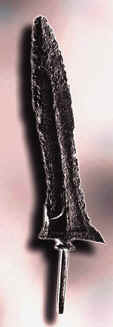 The
oldest keris is made in Java, about 6 or 7 century A.D. This is known as
keris Buda. At the keris making culture infancy, the shape of the first
keris is modest or straight keris. But the iron material in its time is
considered the best, and the way it is made is not far different from
the way it is made now. Keris Buda has no pamor. If there is a pamor in
the keris, it is pamor tiban, or pamor which is not planned by the
Empu.
The
oldest keris is made in Java, about 6 or 7 century A.D. This is known as
keris Buda. At the keris making culture infancy, the shape of the first
keris is modest or straight keris. But the iron material in its time is
considered the best, and the way it is made is not far different from
the way it is made now. Keris Buda has no pamor. If there is a pamor in
the keris, it is pamor tiban, or pamor which is not planned by the
Empu. 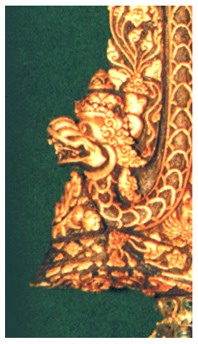 For
the believer, certain keris can add the owner's bravery and confidence.
Keris can also avoid a locust plague or other farming disaster. Keris
can also get rid or cancel the harassment of ghost.
For
the believer, certain keris can add the owner's bravery and confidence.
Keris can also avoid a locust plague or other farming disaster. Keris
can also get rid or cancel the harassment of ghost. 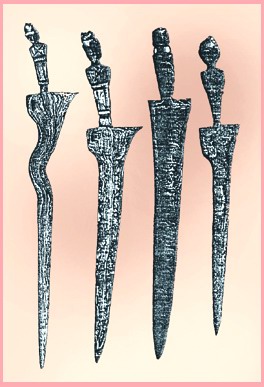 From
various ancient stone inscription found in Java, it is known that keris
once were a necessity of offerings in ritual ceremony at the time. Even
in certain village in Java, even near the end of the Dutch colonial era,
village cleansing ceremony still used a small blade of keris which is
known as keris sajen. Village cleansing is a traditional ritual ceremony
that prays to the God so that the villagers, the farms, are avoided from
disease and pest, and also from natural disaster. The ceremony is meant
to renew the deal or agreement with spiritual beings which inhabit the
village (Sing Mbahureksa - Javanese) so it doesn't interfere with the
villagers. Keris sajen is a simply made small keris. This type of keris
in some Western scholar's book is called the Majapahit keris. So the
naming of this simple keris as keris Majapahit is incorrect. The correct
term is keris sajen, or
keris sesaji.
From
various ancient stone inscription found in Java, it is known that keris
once were a necessity of offerings in ritual ceremony at the time. Even
in certain village in Java, even near the end of the Dutch colonial era,
village cleansing ceremony still used a small blade of keris which is
known as keris sajen. Village cleansing is a traditional ritual ceremony
that prays to the God so that the villagers, the farms, are avoided from
disease and pest, and also from natural disaster. The ceremony is meant
to renew the deal or agreement with spiritual beings which inhabit the
village (Sing Mbahureksa - Javanese) so it doesn't interfere with the
villagers. Keris sajen is a simply made small keris. This type of keris
in some Western scholar's book is called the Majapahit keris. So the
naming of this simple keris as keris Majapahit is incorrect. The correct
term is keris sajen, or
keris sesaji.  In Indonesia, a good keris (beside its pamor) also have golden, silver
or diamond ornament. The ornament is made to enhance the keris, or to
reward the owner of the keris. Gold enhancement can be a reward from the
king for the service of the owner of the keris. The highest order of
ornament is when a keris is given kinatah
or tinatah. The surface of the
keris is chipped and carved with certain motifs to make a surface
picture (relief) and then gilded. Sometimes in the narrows space between
the surface paintings, diamond are placed.
In Indonesia, a good keris (beside its pamor) also have golden, silver
or diamond ornament. The ornament is made to enhance the keris, or to
reward the owner of the keris. Gold enhancement can be a reward from the
king for the service of the owner of the keris. The highest order of
ornament is when a keris is given kinatah
or tinatah. The surface of the
keris is chipped and carved with certain motifs to make a surface
picture (relief) and then gilded. Sometimes in the narrows space between
the surface paintings, diamond are placed. 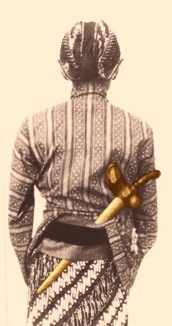
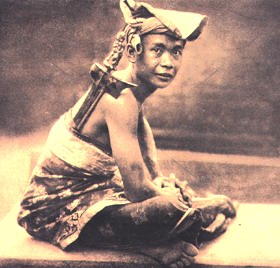
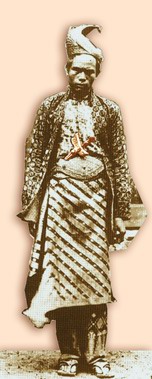
 Most ancient Relief which shows ironworks is found at the stelae found at
Dakuwu Village, Grabag region, Magelang, Central Java.
Most ancient Relief which shows ironworks is found at the stelae found at
Dakuwu Village, Grabag region, Magelang, Central Java. 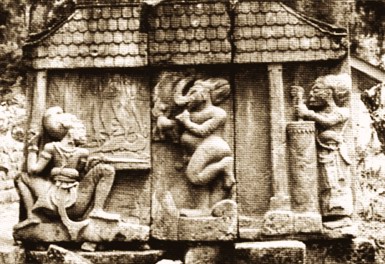 Tak pelak lagi, tentunya yang
dimaksudkan Ma Huan dalam laporannya adalah keris yang kita kenal sekarang
ini.
Tak pelak lagi, tentunya yang
dimaksudkan Ma Huan dalam laporannya adalah keris yang kita kenal sekarang
ini.